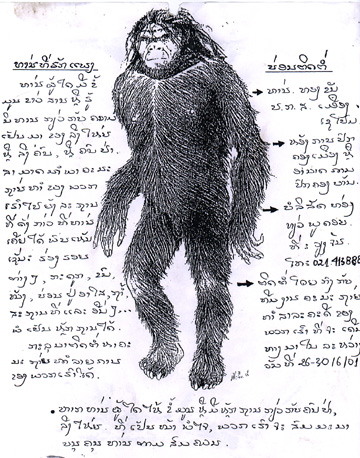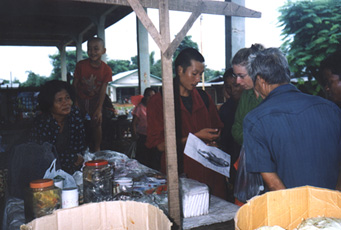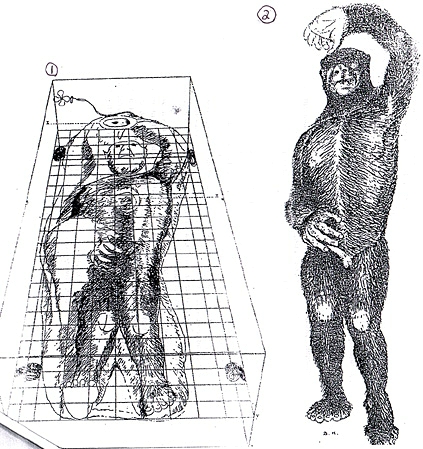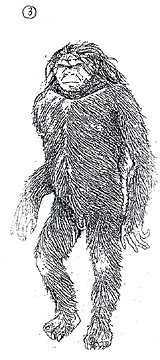
Return to Part 1
July 10, 2001 Xepon, Laos – Copies of the above drawing with descriptions in the Lao language were produced by Bang Productions and distributed in the Xepon market before we arrived on June 28, 2001. The idea was to see how many villagers might have seen any creature that resembled the drawing.


The history behind the drawing is described in an article prepared for the Vietnam Cryptozoic and Rare Animals Research Centre (CRARC) in Hanoi, but so far has not been published. The author is Helmut Loofs-Wissowa on the faculty of Asian Studies, Australian National University, Canberra, Australia. His paper is entitled “Wildman Research in Vietnam in Historical and Geographical Perspective.”
Prof. Loofs-Wissowa reports that as far back as the “first centuries A.D. talk about gigantic apes in the far south of China; a Ming Chinese dictionary mentions a yellow-haired ape with a human face and with human feet, called Sing-sing, known from Yunnan and Tongking; another Chinese dictionary also mentions a huge (3.5 meters tall/ about 12 feet) red-haired ape with a human face, Chan-tu, living in Tongking and southernmost China, which attacks people and eats them.”
American GIs See “Bigfoot” During Vietnam War
The professor outlines other eyewitness reports in the 20th Century, including many described encounters by American GIs.
“One occurred in late 1964 or 1965 just inside Laos, about midway between Lang Mo (North Vietnam) and Ang Kham (Laos) and involved a downed helicopter the four crew members of which were found dead, obviously as a result of the crash.
However, the bodies of four North Vietnamese soldiers were also found nearby without any kind of bullet or combat wounds: they seemed to have died of a broken back! When the montagnards of the rescue patrol saw this, they became very quiet, looked suspiciously around and murmured something about ‘Hairy Man.’
Prof. Loofs-Wissowa also describes another incident that occurred in late 1968 “in a mountain area near a village on the Song Giang in northern Quang Binh Province, North Vietnam, only about 100 kilometers north of the location of the first incident. This time it involved a shot-down U. S. fighter plane. The pilot had ejected and was found hanging by his parachute in a tree above the river, badly wounded, but semi-conscious.
Here again, two North Vietnamese militiamen were found dead near the foot of the tree without visible wounds. When the pilot, a young Lt. Col., was cut down, he still had the force to say that it was ‘a big gorilla’ that had killed the two Vietnamese below.”
The “Minnesota Iceman”
The professor also describes the infamous “Minnesota Iceman,” which was studied by the “Father of Cryptozoology,” Dr. Bernard Heuvelmans in December 1968. Dr. Heuvelmans had been contacted about an unknown hairy adult male human-ape creature frozen in a block of ice on a farm in remote southeastern Minnesota. The scientist traveled to the farm with science writer, Ivan Sanderson, to see for himself. Prof. Loofs-Wissowa summarizes what Dr. Heuvelmans wrote about the Minnesota Iceman in his 1974 book L’Homme de Neanderthal Est Toujours Vivant that includes the drawings the scientist made of the entity in the ice.

Fig. 2: Scientific drawing by Dr. Heuvelmans of the Iceman “after rectification of optical distortions through the ice.” Sketches from book L’Homme de Neanderthal est Toujours Vivant by Dr. Bernard Heuvelmans, Ph.D., and Boris Porchnev, Paris, 1974.
Professor Loofs-Wissowa studied Dr. Heuvelmans’s book and summarized the scientist’s findings this way: “(Dr. Heuvelmans and Ivan Sanderson) were convinced (the entity was) a recently killed (obviously by a bullet) unknown hairy adult male Hominid; the creature, frozen in ice in a supine position, was lying in a large coffin-like freezer through the glass top of which it could be seen as clearly as the varying opacity of the ice allowed.
“For three days, these two very experienced specialists — and in particular Heuvelmans who by then had already firmly established himself as one of the world’s best-known professional zoologists — photographed and sketched the creature from all sides and angles, so as to be able to eventually produce a reliable composite picture of it, including precise measurements
“The most basic one, its height, turned out to be 1.80 meters with knees slightly flexed and 1.84 meters if totally extended, thus exactly 6 feet tall. …There could be no doubt whatsoever that this was a genuine comparatively fresh body and not a dummy as has been suggested by some ill-informed commentators as the putrid odor of decomposing flesh could be perceived. This had already been noticed by earlier visitors amongst whom the professional herpetologist Terry Cullen (he was the one who alerted Ivan Sanderson to the existence of this strange exhibit) who also observed plant matter in the teeth and shed skins of ektoparasites (lice) on the skin of this cadaver, things never ever found on a dummy!”
Frank Hansen told Dr. Heuvelmans and Ivan Sanderson that he bought the creature already encased in a block of ice from a Hong Kong curio dealer who claimed he bought it from Russian seal hunters who found it floating off the coast of the Kamchatka Peninsula. In fact, Hansen first exhibited the Iceman under the name “Sibirskoye Creature.”
But Dr. Heuvelmans decided that since Frank Hansen had been based in an air base in Danang, Vietnam, and since New York’s World Journal Tribune had published a brief story in November 1966 about some kind of ape having been shot by U. S. Marines — that Hansen probably shipped the killed creature home to the United States in a GI coffin in hopes of making money off its exhibition.
Instead, he began to worry about murder and illegal shipment charges and eventually the Minnesota Iceman disappeared, leaving behind only the precise drawings and some photographs taken by Dr. Bernard Heuvelmans and the mystery: was it one of the enigmatic “wild men” of Laos and Vietnam?
Later on, painter Alika Lindbergh worked under the scientific supervision of Dr. Heuvelmans to reconstitute a drawing of what the Homo pongoides might have looked like alive and standing on its feet. The result is Figure 3 in Dr. Heuvelmans’s book. The same drawing was used on the leaflets that Bang Productions Ltd. handed out at the market in Xepon, Laos.

January 1996 – Wildmen Research in Ban Kador, Laos
Villagers in Ban Kador, Laos near the Vilaburi (Vilabouli) region beyond Xepon talked to Prof. Helmut Loofs-Wissowa in January 1996 about the Heuvelmans drawing below. The professor wrote about his trip to Ban Kador in a paper entitled “Hard on the Heels of Wildman in Laos: A Report of Work in 1996.” The village Headman talked with knowledge about a creature called Briau (BREE-ow) that “walks upright on two legs like a man, has long arms, dark brown to black fur with a reddish tinge and is very dangerous.”
When the professor spread out a dozen pictures and drawings of apes and prehistoric man, including the reconstituted drawing of the Minnesota Iceman, in front of Ban Kador villagers, everybody pointed to Dr. Heuvelmans’s Homo pongoides drawing as being the best likeness.
Continued in Part 4: The Rugged Road to Vilabouli
More Information:
Eyewitness of “Iceman” at Minnesota State Fair:
I received an e-mail from a Minneapolis, Minnesota resident which reads:
“I’m writing because I saw the ‘Iceman’ at the Minnesota State Fair. The year was either 1968 or 1969. I’m not exactly sure which year.
I remember going into the back of small enclosed trailer or semi-truck and paying probably 50 cents to see this thing. I was very skeptical when I went in. Upon climbing up the stairs into the trailer, I went inside to a single room. There was a large freezer on the ground. Encased in a solid block of clear ice was the ‘Iceman.’
I really expected the thing to be a dummy made of wax. You could walk all the way around the freezer and gaze down on the thing. Press your nose up against the glass. What I remember observing was mainly the face of the thing. I remember looking closely at the facial hair. Very closely I could look down on this thing from directly above the glass freezer case and see the tiny pores on the face. And from each pore on the lower part of the face, there was a black hair coming out. The eyes were shut. The detail was amazing. It looked real. I was impressed. I remember thinking that this could be a real body.
I remember the facial characteristics were reminiscent of drawings I have seen in the past of what a caveman might look like. Wide face. Very hairy over the whole body and face. The skin color was of a Caucasian human. About five feet tall. I don’t remember the lower half of the body that well. I think the way the thing was set in the ice, the head was closer to the surface of the ice than the lower torso. I don’t remember seeing any genitals. Maybe this part of the body was obscured by ice. The thing was quite hairy.”
© 1998 - 2025 by Linda Moulton Howe.
All Rights Reserved.

